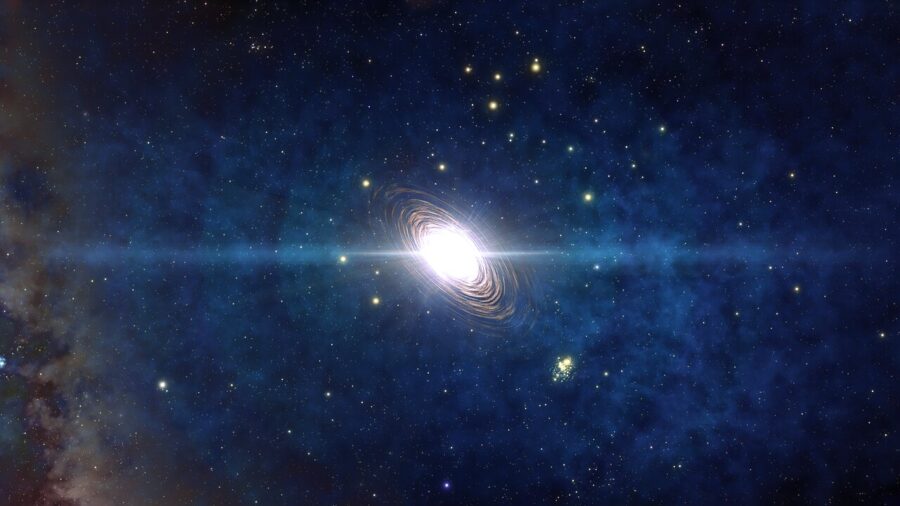New evidence suggests the first stars to shine in the universe formed in groups.

NOIRLab / NSF / AURA / J. da Silva / Spaceengine
More often than not, the universe’s very first stars didn’t live a solitary life but formed in small groups and clusters instead. That’s what Tilman Hartwig (University of Tokyo) and his colleagues conclude in a recent paper in The Astrophysical Journal, after comparing observations with computer calculations. “It’s an exciting result, with far-reaching consequences,” says Simon Portegies Zwart (Leiden Observatory, The Netherlands), who wasn’t involved with the study.
No one has ever seen a true first-generation star. Born shortly after the Big Bang from primordial clouds of hydrogen and helium, these massive stars (also called Population III stars, for historical reasons) only lived for a few million years or so before going supernova. Little is known about the circumstances of their origin, or their masses — information that is crucial for better understanding the formation and early evolution of the very first galaxies.
So, to learn more about the first generation of stars, Hartwig and his Japanese colleagues studied the composition of the second generation. So-called Population II stars are born from interstellar clouds that are already slightly enriched with heavier elements, forged in the cores of Population III stars and blown into space when these earlier stars exploded.
Through detailed calculations of stellar nucleosynthesis, astronomers know the mix of elements that Population III supernovae of various masses should produce. Comparing the yields of these supernovae with the observed abundances of heavy elements in a Population II star tells astronomers whether this next-generation star was born from material enriched by a single supernova or by multiple explosions in the same region.
The team collected archival data on the composition of 462 Population II stars (also called extremely metal-poor stars) in our own Milky Way galaxy. Together with their own theoretical results on supernova yields, they fed these data into a machine-learning neural network. The result: just one-third of the stars appears to have formed from material enriched by only one supernova.
“This means that the majority of extremely metal poor stars are likely multi-enriched, suggesting that the first stars were born in small clusters,” the authors write.
It might not be surprising that most Population III stars were born in small groups or clusters, since the same is true of the most massive stars born today. “But for the first time,” says Portegies Zwart, “this paper provides a benchmark in a discussion that has been going on for a long time.”
 3
3









Comments
Martian-Bachelor
March 31, 2023 at 8:14 pm
I'm not sure I understand how the conclusion follows from what we're given here. The metallicity of the Gen-2 stars is going to reflect the enrichment factor of the gas they form out of, which depends not only on the number of Pop III SNe but also on how much gas is involved. It doesn't matter if its one SN and ten solar masses of gas (say) making one or two stars, or ten SNe enriching 100 solar masses of gas and making ten or twenty stars, the net result would be the same enrichment level.
You must be logged in to post a comment.
louis-robinson
April 1, 2023 at 12:43 am
You're right that the relevant information isn't explicitly stated, but it is implied by the reference to "the mix of elements that Population III supernovae of various masses should produce". What's important isn't the concentrations, but the relative abundances of the various elements [isotope abundances are even more revealing, but extremely difficult to measure in astrophysical contexts], which are thought to be quite distinctive for different stellar mass ranges. So if you find a star with an abundance profile that doesn't match anything predicted for stars of the Pop III mass range you know that it must have formed from a mixture of sources - and you can often determine how many different mass ranges were involved as long as the number stays fairly small. And the odds are that there was only one star in each of those ranges, although that is hard to prove. It's only if every star in a cluster has nearly the same mass that the situation you describe would occur.
You must be logged in to post a comment.
Rod
April 2, 2023 at 7:47 am
Okay, Population III stars are only theory, not observed like Galileo did for the Galilean moons. None observed, no spectrum taken and the original pristine, primordial gas clouds that show zero metals - not observed either. There is no H1 21-cm line measured during the cosmic dark ages or H-alpha in the CMBR too (there are reports about this). Some do look for very small Population III stars in the mass range 0.15 to 1.0 solar mass (not seen yet).
WHERE ARE THE LOW-MASS POPULATION III STARS?, https://iopscience.iop.org/article/10.3847/0004-637X/826/1/9, 14-July-2016. "...Assuming a Kroupa initial mass function (IMF) from 0.15 to 1.0 M⊙ for low-mass Pop III stars, as a working hypothesis, we try to constrain the theoretical models in reverse by current and future observations."
There are models for 10,000 and 100, 000 solar mass stars in the early universe used as seeds to create SMBHs. The first stars may have held up to 100,000 times the mass of the sun, https://phys.org/news/2023-02-stars-held-mass-sun.html
You must be logged in to post a comment.
You must be logged in to post a comment.